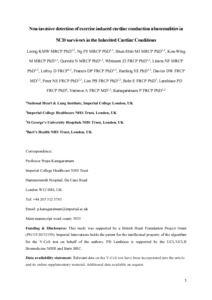Leong, KMW;
Ng, FS;
Shun-Shin, MJ;
Koa-Wing, M;
Qureshi, N;
Whinnett, ZI;
Linton, NF;
Lefroy, D;
Francis, DP;
Harding, SE;
et al.
Leong, KMW; Ng, FS; Shun-Shin, MJ; Koa-Wing, M; Qureshi, N; Whinnett, ZI; Linton, NF; Lefroy, D; Francis, DP; Harding, SE; Davies, DW; Peter, NS; Lim, PB; Behr, E; Lambiase, PD; Varnava, A; Kanagaratnam, P
(2021)
Non-invasive detection of exercise-induced cardiac conduction abnormalities in sudden cardiac death survivors in the inherited cardiac conditions.
Europace, 23 (2).
pp. 305-312.
ISSN 1532-2092
https://doi.org/10.1093/europace/euaa248
SGUL Authors: Behr, Elijah Raphael
![[img]](https://openaccess.sgul.ac.uk/112558/1.hassmallThumbnailVersion/V-CoS%20in%20SCD%20survivors%20EP%20accepted.pdf)  Preview |
|
PDF
Accepted Version
Available under License ["licenses_description_publisher" not defined].
Download (897kB)
| Preview
|
Abstract
AIMS : Rate adaptation of the action potential ensures spatial heterogeneities in conduction across the myocardium are minimized at different heart rates providing a protective mechanism against ventricular fibrillation (VF) and sudden cardiac death (SCD), which can be quantified by the ventricular conduction stability (V-CoS) test previously described. We tested the hypothesis that patients with a history of aborted SCD due to an underlying channelopathy or cardiomyopathy have a reduced capacity to maintain uniform activation following exercise. METHODS AND RESULTS : Sixty individuals, with (n = 28) and without (n = 32) previous aborted-SCD event underwent electro-cardiographic imaging recordings following exercise treadmill test. These included 25 Brugada syndrome, 13 hypertrophic cardiomyopathy, 12 idiopathic VF, and 10 healthy controls. Data were inputted into the V-CoS programme to calculate a V-CoS score that indicate the percentage of ventricle that showed no significant change in ventricular activation, with a lower score indicating the development of greater conduction heterogeneity. The SCD group, compared to those without, had a lower median (interquartile range) V-CoS score at peak exertion [92.8% (89.8-96.3%) vs. 97.3% (94.9-99.1%); P < 0.01] and 2 min into recovery [95.2% (91.1-97.2%) vs. 98.9% (96.9-99.5%); P < 0.01]. No significant difference was observable later into recovery at 5 or 10 min. Using the lowest median V-CoS scores obtained during the entire recovery period post-exertion, SCD survivors had a significantly lower score than those without for each of the different underlying aetiologies. CONCLUSION : Data from this pilot study demonstrate the potential use of this technique in risk stratification for the inherited cardiac conditions.
| Item Type: |
Article
|
| Additional Information: |
This is a pre-copyedited, author-produced version of an article accepted for publication in Europace following peer review. The version of record Kevin Ming Wei Leong, Fu Siong Ng, Matthew J Shun-Shin, Michael Koa-Wing, Norman Qureshi, Zachary I Whinnett, Nick F Linton, David Lefroy, Darrel P Francis, Sian E Harding, D Wyn Davies, Nicholas S Peter, Phang Boon Lim, Elijah Behr, Pier D Lambiase, Amanda Varnava, Prapa Kanagaratnam, Non-invasive detection of exercise-induced cardiac conduction abnormalities in sudden cardiac death survivors in the inherited cardiac conditions, EP Europace, Volume 23, Issue 2, February 2021, Pages 305–312 is available online at: https://doi.org/10.1093/europace/euaa248 |
| Keywords: |
Brugada syndrome, Hypertrophic cardiomyopathy, Idiopathic ventricular fibrillation, Risk stratification, Sudden cardiac death, Ventricular conduction stability, Brugada syndrome, Hypertrophic cardiomyopathy, Idiopathic ventricular fibrillation, Risk stratification, Sudden cardiac death, Ventricular conduction stability, Cardiovascular System & Hematology, 1103 Clinical Sciences |
| SGUL Research Institute / Research Centre: |
Academic Structure > Molecular and Clinical Sciences Research Institute (MCS) |
| Journal or Publication Title: |
Europace |
| ISSN: |
1532-2092 |
| Language: |
eng |
| Dates: |
| Date | Event |
|---|
| February 2021 | Published | | 21 October 2020 | Published Online | | 18 August 2020 | Accepted |
|
| Publisher License: |
Publisher's own licence |
| Projects: |
|
| PubMed ID: |
33083839 |
 |
Go to PubMed abstract |
| URI: |
https://openaccess.sgul.ac.uk/id/eprint/112558 |
| Publisher's version: |
https://doi.org/10.1093/europace/euaa248 |
Statistics
Item downloaded times since 02 Nov 2020.
Actions (login required)
 |
Edit Item |



